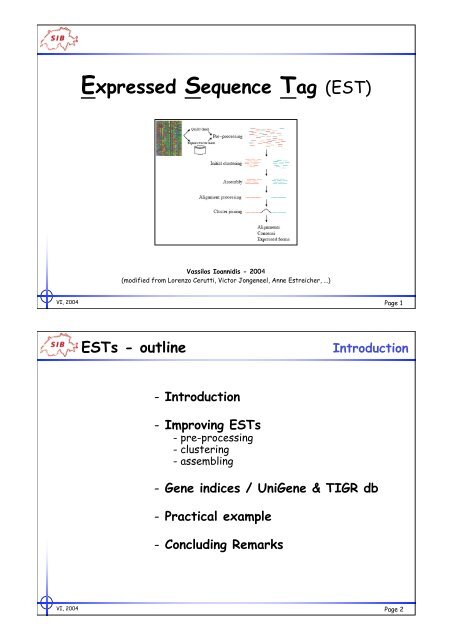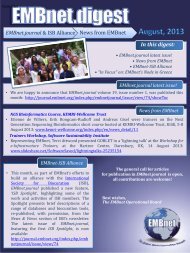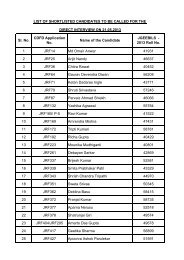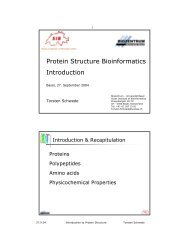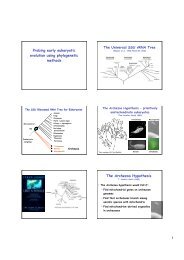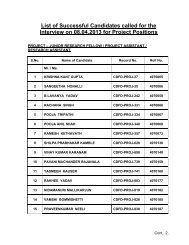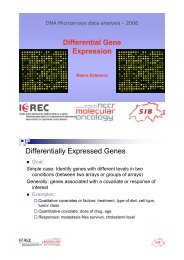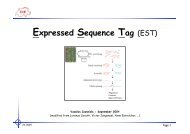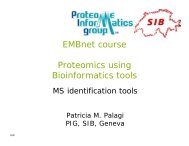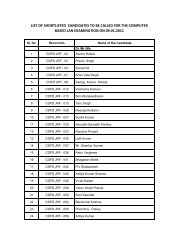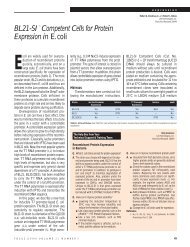Expressed Sequence Tag (EST)
Expressed Sequence Tag (EST)
Expressed Sequence Tag (EST)
- No tags were found...
Create successful ePaper yourself
Turn your PDF publications into a flip-book with our unique Google optimized e-Paper software.
<strong>Expressed</strong> <strong>Sequence</strong> <strong>Tag</strong> (<strong>EST</strong>)Vassilos Ioannidis - 2004(modified from Lorenzo Cerutti, Victor Jongeneel, Anne Estreicher, …)VI, 2004 Page 1<strong>EST</strong>s - outlineIntroduction- Introduction- Improving <strong>EST</strong>s- pre-processing- clustering- assembling- Gene indices / UniGene & TIGR db- Practical example- Concluding RemarksVI, 2004 Page 2
Transcriptome sequencingIntroduction«!Traditional!» sequencingcDNA clones isolated on the basis of some functional property of interestto a group<strong>EST</strong> sequencingLarge-scale sampling of end sequences of all cDNA clones present in alibrary«!Full-length!» sequencingSystematic attempts to obtain high-quality sequences of cDNA clonesrepresenting all transcribed genesVI, 2004 Page 3What are <strong>EST</strong>sIntroduction• cDNA libraries prepared from various organisms, tissues and cell linesusing directional cloning• Gridding of individual clones using robots• For each clone, single-pass sequencing of both ends (5’ and/or 3’) of insert• Deposit readable part of sequence in database• <strong>EST</strong>s represent partial sequences of cDNA clones (300 bp -> 700 bp)VI, 2004 Page 4
What are <strong>EST</strong>sIntroductionmRNAmRNAcDNAcDNAAAAAAAAAAASynthesis of 1 strand of DNA(Reverse Transcriptase)RNA degradationSynthesis of 2 strand of DNA(DNA Polymerase)cDNAT73’ 5’5’ 3’T3Cloning &SequencingMCSCloning vectorVI, 2004 Page 5Why <strong>EST</strong> sequencing?Introduction• Fast & cheap (almost all steps are automated)• They represent the most extensive available survey of the transcribed portionof genomes.• There are indispensable for gene structure prediction, gene discovery andgenome mapping:-> provide experimental evidence for the position of exons-> provide regions coding for potentially new proteins-> characterization of splice variants and alternative polyadenilation• Provide an alternative to library screening-> short tag can lead to a cDNA clone• Provide an alternative to full-length cDNA sequencing-> sequences of multiple <strong>EST</strong>s can reconstitute a full-length cDNA• Single Nucleotide Polymorphism (SNP) data miningVI, 2004 Page 6
cDNA librariesIntroduction• Most are “native”, meaning that clone frequency reflects mRNAabundance• Most are primed with oligo(dT), meaning that 3’ ends are heavilyrepresented• The complexity of libraries is extremely variable• “Normalized” libraries are used to enrich for rare mRNAsVI, 2004 Page 7cDNA libraries usedIntroduction• Large number of libraries represented• Most libraries managed by the IMAGE consortium (http://image.llnl.gov/)• Human & mouse libraries are the most abundantly represented:• Many tissues still not sampled• Quality very unevenVI, 2004 Page 8
<strong>EST</strong> databasesIntroductionThe data sources for clustering can be in-house, proprietary, public database ora hybrid of this (chromatograms and/or sequence files).Each <strong>EST</strong> must have the following information:• A sequence ID (ex. sequence-run ID)• Location in respect of the poly A (3' or 5')• The CLONE ID from which the <strong>EST</strong> has been generated• Organism• Tissue and/or conditions• The sequenceThe <strong>EST</strong> can be stored in FASTA format:>T27784 <strong>EST</strong>16067 Human Endothelial cells Homo sapiens cDNA 5'CCCCCGTCTCTTTAAAAATATATATATTTTAAATATACTTAAATATATATTTCTAATATCTTTAAATATATATATATATTTNAAAGACCAATTTATGGGAGANTTGCACACAGATGTGAAATGAATGTAATCTAATAGANGCCTAATCAGCCCACCATGTTCTCCACTGAAAAATCCTCTTTCTTTGGGGTTTTTCTTTCTTTCTTTTT………VI, 2004 Page 9<strong>EST</strong> databasesIntroductionPublic <strong>EST</strong> databases• EMBL/GenBank have separate sections for <strong>EST</strong> sequences• <strong>EST</strong>s are the most abundant entries in the databases (>60%)• <strong>EST</strong>s are now separated by division in the databases:-> human, mouse, plant, prokaryote, … (EMBL)• <strong>EST</strong>s sequences are submitted in bulk, but do have to meet minimal qualitycriteria (“Phred” score >20%, ie
<strong>EST</strong> / <strong>EST</strong> databases qualityIntroduction• <strong>EST</strong>s represent partial sequences of cDNA clones (300 bp -> 700 bp)-> No attempt to obtain the complete sequence (no overlap necessary)-> A single <strong>EST</strong> represents only a partial gene sequence-> Not a defined gene/protein product• Single, unverified runs from the 5’ and/or 3’ ends of cDNA clones-> high error rates (~1/100)-> frequent sequence compression and frame-shift errors• Trivial contaminants are common (vector, rRNA, mitRNA, … )• Not curated in a highly annotated form• High redundancy in the data (“native” databases: clone frequency reflects mRNA abundance)• Databases are skewed for sequences near 3’-end of mRNAs (normalization)• For most <strong>EST</strong>s, no indication as to the gene from which they are derivedVI, 2004 Page 11Clone availabilityIntroduction• In principle, all clones produced by IMAGE are publicly availableDistributors:- US: ATCC (http://www.lgcpromochem.com/atcc/) and Invitrogen(http://clones.invitrogen.com/cloneinfo.php?clone=est)- UK: HGMP (http://www.hgmp.mrc.ac.uk/geneservice/reagents/index.shtml)- D: RZPD (http://www.rzpd.de/products/clones/)Notice:- Error rate is high: ~30% chance that clone doesn’t have expected sequence- Invitrogen sells sets of sequence verified clonesVI, 2004 Page 12
<strong>EST</strong> entry in EMBLIntroductionID AI242177 standard; RNA; <strong>EST</strong>; 581 BP.AC AI242177;SV AI242177.1DT 05-NOV-1998 (Rel. 57, Created)DT 03-MAR-2000 (Rel. 63, Last updated, Version 3)DE qh81g08.x1 Soares_fetal_liver_spleen_1NFLS_S1 Homo sapiens cDNADE clone IMAGE:1851134 3' similar to gb:M10988 TUMOR NECROSIS FACTORDE PRECURSOR (HUMAN);, mRNA sequence.RN [1]RP 1-581RA NCI-CGAP;RT National Cancer Institute, Cancer Genome Anatomy Project (CGAP), TumorRT Gene Index http://www.ncbi.nlm.nih.gov/ncicgap;RL Unpublished.DR RZPD; IMAGp998P154529; IMAGp998P154529.CC On May 19, 1998 this sequence version replaced gi:2846208.CC Contact: Robert Strausberg, Ph.D.CC Tel: (301) 496-1550CC Email: Robert_Strausberg@nih.govCC This clone is available royalty-free through LLNL ; contact theCC IMAGE Consortium (info@image.llnl.gov) for further information.CC Insert Length: 1280 Std Error: 0.00CC Seq primer: -40UP from GibcoCC High quality sequence stop: 463.VI, 2004 Page 13<strong>EST</strong> entry in EMBLIntroductionFH Key Location/QualifiersFHFT source 1..581FT /db_xref=taxon:9606FT /db_xref=<strong>EST</strong>LIB:452FT /db_xref=RZPD:IMAGp998P154529FT /note=Organ: Liver and Spleen; Vector: pT7T3D (Pharmacia)FT with a modified polylinker; Site_1: Pac I; Site_2: Eco RI;FT This is a subtracted version of the original Soares fetalFT liver spleen 1NFLS library. 1st strand cDNA was primedFT with a Pac I - oligo(dT) primer [5'FT AACTGGAAGAATTAATTAAAGATCTTTTTTTTTTTTTTTTTTT 3'],FT double-stranded cDNA was ligated to Eco RI adaptorsFT (Pharmacia), digested with Pac I and cloned into the Pac IFT and Eco RI sites of the modified pT7T3 vector. LibraryFT went through one round of normalization. LibraryFT constructed by Bento Soares and M.Fatima Bonaldo.FT /sex=maleFT /organism=Homo sapiensFT /clone=IMAGE:1851134FT /clone_lib=Soares_fetal_liver_spleen_1NFLS_S1FT /dev_stage=20 week-post conception fetusFT /lab_host=DH10B (ampicillin resistant)SQ <strong>Sequence</strong> 581 BP; 179 A; 130 C; 135 G; 137 T; 0 other;cttttctaag caaactttat ttctcgccac tgaatagtag ggcgattaca gacacaactc 60…………VI, 2004 Page 14
From an <strong>EST</strong> entry in EMBL to clone shoppingVI, 2004 Page 15Improving <strong>EST</strong>sIntroductionThe value of <strong>EST</strong>s can be greatly enhanced by• Pre-processing(Steps required to “clean” & prepare <strong>EST</strong>s sequences)• Clustering(minimization of the chance to cluster unrelated sequences)• Assembling(derive consensus sequences from overlapping <strong>EST</strong>s belonging to the same cluster)• Mapping(associate <strong>EST</strong>s or <strong>EST</strong>s contigs with exons in genomic sequences)• Interpretingin order to :(find and correct coding regions)-> solve redundancy & help correcting errors-> get longer & better annotated sequences-> allow easier association to mRNAs & proteins-> allow detection of splice variants-> fewer sequences to analyzeVI, 2004 Page 16
Improving <strong>EST</strong>sPre-processing<strong>EST</strong> pre-processing consists in a number of essential steps to minimize thechance to cluster unrelated sequences:• Screening out low quality regions:- Low quality sequence readings are error prone• Screening out contaminations (rRNA, mitRNA, … )• Screening out vector sequences (vector clipping)• Screening out repeat sequences (repeat masking)• Screening out low complexity sequencesSoftwares:• Phred (Ewig et al., 1998)- Reads chromatograms and assesses a quality value to each nucleotide• VecScreen (http://www.ncbi.nlm.nih.gov/VecScreen)• RepeatMasker (http://ftp.genome.washington.edu/RM/RepeatMasker.html)• …VI, 2004 Page 17Improving <strong>EST</strong>sPre-processingVector clipping and contaminations• Vector sequences can skew clustering even if a small vector fragment remainsin each read. Therefore vector sequences must be removed:- Delete 5’ and 3’ regions corresponding to the vector used for cloning- Detection of vector sequences is not a trivial task, because they usuallylie in the low quality region of the sequence- UniVec is a non-redundant vector database available from the NCBI(http://www.ncbi.nlm.nih.gov/VecScreen/UniVec.html)• Contaminations can also skew clustering and therefore must be removed:- Find and delete bacterial DNA, yeast DNA, …Standard pairwise alignment programs are used for the detection of vectorsequences and other contaminants (cross-match, BLASTN, FASTA,… )VI, 2004 Page 18
Improving <strong>EST</strong>sPre-processingRepeats masking• Some repetitive elements found in the human genome:Fraction ofLength Copy numberthe genome_______________________________________________________________LINEs (long interspersed elements) 6-8 kb 850’000 21%SINEs (short interspersed elements) 100-300 bp 1’500’000 13%LTR (autonomous)LTR (non-autonomous)DNA transposons (autonomous)DNA transposons (non-autonomous)6-11 kb1.5-3 kb2-3 kb80-3000 bp450’000 8%300’000 3%SSRs (simple sequence repeats or micro satellites and mini satellites) 3%VI, 2004 Page 19Improving <strong>EST</strong>sPre-processingRepeats masking• Repeated elements:- They represent a big part of the mammalian genome- They are found in a number of genomes (plants, …)- They induce errors in clustering and assembling- They should be MASKED, not deleted, to avoid false sequence assembling(also interesting for evolutionary studies. SSRs important for mapping of diseases)• Tools to find repeats:- RepeatMasker has been developed to find repetitive elements and lowcomplexitysequences. It uses the cross-match program for the pairwisealignments (http://www.repeatmasker.org/cgi-bin/WEBRepeatMasker)- MaskerAid improves the speed of RepeatMasker by ~30 folds using WU-BLAST instead of cross-match (http://sapiens.wustl.edu/maskeraid)- RepBase is a database of prototypic sequences representing repetitive DNAfrom different eukaryotic species (http://www.girinst.org/Repbase_Update.html)VI, 2004 Page 20
Improving <strong>EST</strong>sPre-processingLow complexity masking• Low complexity sequences contain an important bias in their nucleotidecompositions (poly A tracts, AT repeats, etc.)• Low complexity regions can provide an artifactual basis for cluster membership• Clustering strategies employing alignable similarity in their first pass are verysensitive to low complexity sequences• Some clustering strategies are insensitive to low complexity sequences, becausethey weight sequences in respect to their information content (ex. d2-cluster).• Programs as DUST (NCBI) can be used to mask low complexity regionsVI, 2004 Page 21Improving <strong>EST</strong>sPre-processingBase callingSelect high quality readsATGAATGTAATCTAATAGANGCCTAATCAGCCCACCATGTTCTCCACTGAAAAATCCTCTCCCCCGTCTCTTTAAAAATATATATATTTTAAATATACTTAAATATATATTTCTAATATCTTTAAATATATATATATATTTNAAAGACCAATTTATGGGAGANTTGCACACAGATGTGAATTCTTTGGGGTTTTTCTTTCTTTCTTTTTTGATTTTGCACTGGACGGTGACGTCAGCCATGTACAGGATCCACAGGGGTGGTGTCAAATGCTATTGAAATTNTGTTGAATTGTATACTTTTTCACTTTTTGATAATTAACCATGTAAAAAATGAACGCTACTACTATAGTAGAATTGATVector clippingCCCCCGTCTCTTTAAAAATATATATATTTTAAATATACTTAAATATATATTTCTAATATCTTTAAATATATATATATATTTNAAAGACCAATTTATGGGAGANTTGCACACAGATGTGAAATGAATGTAATCTAATAGANGCCTAATCAGCCCACCATGTTCTCCACTGAAAAATCCTCTTTCTTTGGGGTTTTTCTTTCTTTCTTTTTTGATTTTGCACTGGACGGTGACGTCAGCCATGTACAGGATCCACAGGGGTGGTGTCAAATGCTATTGAAATTNTGTTGAATTGTATACTTTTTCACTTTTTGATAATTAACCATGTAAAAAATGXXXXXXXXXXXXXXXXXXXXXXXXXXRepeat/Low complexity maskingCCCCCGTCTCTTTAAAANNNNNNNNNNNNNNNNNNNNNNNNNNNNNNNNNNNNNNNNNNNNNNNNNNNNNNNNNNNNNNTTNAAAGACCAATTTATGGGAGANTTGCACACAGATGTGAAATGAATGTAATCTAATAGANGCCTAATCAGCCCACCATGTTCTCCACTGAAAAATCCTCTTTCTTTGGGGTTTTTCTTTCTTTCTTTTTTGATTTTGCACTGGACGGTGACGTCAGCCATGTACAGGATCCACAGGGGTGGTGTCAAATGCTATTGAAATTNTGTTGAATTGTATACTTTTTCACTTTTTGATAATTAACCATGTAAAAAATGXXXXXXXXXXXXXXXXXXXXXXXXXX<strong>Sequence</strong> ready for clusteringCCCCCGTCTCTTTAAAANNNNNNNNNNNNNNNNNNNNNNNNNNNNNNNNNNNNNNNNNNNNNNNNNNNNNNNNNNNNNNTTNAAAGACCAATTTATGGGAGANTTGCACACAGATGTGAAATGAATGTAATCTAATAGANGCCTAATCAGCCCACCATGTTCTCCACTGAAAAATCCTCTTTCTTTGGGGTTTTTCTTTCTTTCTTTTTTGATTTTGCACTGGACGGTGACGTCAGCCATGTACAGGATCCACAGGGGTGGTGTCAAATGCTATTGAAATTNTGTTGAATTGTATACTTTTTCACTTTTTGATAATTAACCATGTAAAAAATGVI, 2004 Page 22
Improving <strong>EST</strong>sClustering<strong>EST</strong> clustering consists in incorporating overlapping <strong>EST</strong>s which tag the sameTranscript of the same gene in a single clusterFor clustering, we measure the similarity (distance) between any 2 sequences.The distance is then reduced to a simple binary value:- accept or reject two sequences in the same clusterSimilarity can be measured using different algorithms:• Pairwise alignment algorithms:Smith-Waterman is the most sensitive, but time consuming (ex. cross-match);Heuristic algorithms, as BLAST and FASTA, trade some sensitivity for speed.• Non-alignment based scoring methods:d2-cluster algorithm: based on word comparison and composition (word identityand multiplicity) (Burke et al., 99). No alignments are performed ) fast.VI, 2004 Page 23Improving <strong>EST</strong>sClusteringStringent clustering:• Greater initial fidelity• One pass• Lower coverage of expressed gene data• Lower cluster inclusion of expressed gene forms• Shorter consensiTIGRLoose clustering:• Lower initial fidelity• Multi-pass• Greater coverage of expressed gene data• Greater cluster inclusion of alternate expressed forms• Longer consensi• Risk to include paralogs in the same gene indexUniGeneVI, 2004 Page 24
Improving <strong>EST</strong>sClusteringSupervised clustering• <strong>EST</strong>s are classified with respect to known reference sequences or "seeds" (fulllength mRNAs, exon constructs from genomic sequences, previously assembled<strong>EST</strong> cluster consensus)Unsupervised clustering• <strong>EST</strong>s are classified without any prior knowledge (“ab initio”)The two major gene indices use different <strong>EST</strong> clustering methods:• TIGR Gene Index uses a stringent and supervised clustering method, whichgenerates shorter consensus sequences and separates splice variants• A combination of supervised and unsupervised methods with variable levels ofstringency is used in UniGene. No consensus sequences are producedVI, 2004 Page 25Improving <strong>EST</strong>sAssemblingAssembling, processing and cluster joining• A multiple alignment for each cluster can be built (assembly) and consensussequences generated (processing)• A number of program are available for assembly and processing:- PHRAP (http://www.phrap.org/)- TIGR ASSEMBLER (Sutton et al., 95)- …• Assembly and processing result in the production of consensus sequencesand singletons.• Consensus sequences are useful:- to help visualizing splice variants;- to reduce the size of data to analyze;- for gene structure;- ...UniGeneTIGRVI, 2004 Page 26
Improving <strong>EST</strong>sAssemblingAssembling, processing and cluster joining• All <strong>EST</strong>s generated from the same cDNA clone correspond to a single gene• Generally the original cDNA clone information is available (~90%)• Using the cDNA clone information and the 5’ and 3’ reads information,clusters can be joinedAssembly &ProcessingJoiningVI, 2004 Page 27The need for a gene indexU&T db- All high-throughput biology methods require a unique and reliable way todescribe the genes they are analyzing- This index should be stable, unique, extensible, and independent of asystem of nomenclature- The index should document all transcript sequences belonging to thecorresponding geneVI, 2004 Page 28
Some commonly used gene indicesU&T db• EMBL/GenBank/DDBJ accession numbers• Unique and universally accepted BUT• Highly redundant (many entries per gene)• Unigene cluster identifiers (NCBI)• Widely used and non-redundant BUT• Rely on clustering procedure (unreliable) AND• Unstable – clusters change with each build• RefSeq accession numbers (NCBI)• Stable and non-redundant BUT• Still very far from comprehensive AND• Many RefSeq sequences are incomplete AND• Splice variants are not systematically documentedVI, 2004 Page 29Indices: The Unigene databaseU&T dbVI, 2004 Page 30
Indices: The Unigene databaseU&T db• Unigene (http://www.ncbi.nlm.nih.gov/UniGene/) is an ongoing effort at NCBI tocluster <strong>EST</strong> sequences with traditional gene sequences• For each cluster, there is a lot of additional information included(Represented organisms comprise animals & plants)• Unigene is regularly rebuilt. Therefore:cluster identifiers are not stable gene indices !!!VI, 2004 Page 31Indices: The Unigene databaseU&T dbUniGene procedure: (supervised or unsupervised, multipass)Screen for contaminants, repeats, and low-complexity regions in GenBank:- Low-complexity are detected using Dust- Contaminants (vector, linker, bacterial, mitochondrial, ribosomal sequences)are detected using pairwise alignment programs- Repeat masking of repeated regions (RepeatMasker)- Only sequences with at least 100 informative bases are acceptedClustering procedure:- Build clusters of genes and mRNAs (GenBank)- Add <strong>EST</strong>s to previous clusters (megablast)- <strong>EST</strong>s that join two clusters of genes/mRNAs are discarded- Any resulting cluster without a polyadenilation signal or at least two 3' <strong>EST</strong>sis discarded (*)- The resulting clusters are called anchored clusters since their 3' end issupposed known(*: UniGene rule)VI, 2004 Page 32
Indices: The Unigene databaseU&T dbUniGene procedure:Ensures that the 5' and 3' <strong>EST</strong>s from the same cDNA clone belongs to thesame cluster<strong>EST</strong>s that have not been clustered, are reprocessed with lower level ofstringency<strong>EST</strong>s added during this step are called guest membersClusters of size 1 (containing a single sequence) are compared against therest of the clusters with a lower level of stringency and merged with thecluster containing the most similar sequenceFor each build of the database, clusters IDs change if clusters are split ormerged.VI, 2004 Page 33Indices: The TIGR databaseU&T dbVI, 2004 Page 34
Indices: The TIGR databaseU&T dbTIGR produces Gene Indices for a number of organisms (http://www.tigr.org/tdb/tgi).TIGR Gene Indices are produced using stringent supervised clustering methodsClusters are assembled in consensus sequences, called tentative consensus (TC)sequences, that represent the underlying mRNA transcriptsThe TIGR Gene Indices building method tightly groups highly relatedsequences and discard under-represented, divergent, or noisy sequencesTIGR Gene Indices characteristics:- separate closely related genes into distinct consensus sequences;- separate splice variants into separate clusters;- low level of contamination.TC sequences can be used for genome annotation, genome mapping, andidentification of orthologs/paralogs genesVI, 2004 Page 35Indices: The TIGR databaseU&T dbTIGR procedure: (supervised, stringent)<strong>EST</strong> sequences recovered form db<strong>EST</strong> (http://www.ncbi.nlm.nih.gov/db<strong>EST</strong>);<strong>Sequence</strong>s are trimmed to remove:– vectors– polyA/T tails– adaptor sequences– bacterial sequencesGet expressed transcripts (ETs) from EGAD (http://www.tigr.org/tdb/egad/egad.shtml)– EGAD (<strong>Expressed</strong> Gene Anatomy Database) is based on mRNA and CDS (coding sequences)from GenBankGet TCs and singletons from previous database buildSupervised and strict clustering– Use ETs, TCs, and CDSs as seed;– Compare cleaned <strong>EST</strong>s to the template using FLAST (a rapid pairwise comparison– program).– <strong>Sequence</strong>s are grouped in the same cluster if these conditions are true:• a minimum of 40 base pair match• greater than 94% identity in the overlap region• a maximum unmatched overhang of 30 base pairsVI, 2004 Page 36
Indices: The TIGR databaseU&T dbTIGR procedure:Each cluster is assembled using CAP3 assembling program to produce tentativeconsensus (TC) sequences.– CAP3 can generate multiple consensus sequences for each cluster– CAP3 rejects chimeric, low-quality and non-overlapping sequences– New TCs resulting from the joining or splitting of previous TCs, get a new TC IDBuild TCs are loaded in the TIGR Gene Indices database and annotated usinginformation from GenBank and/or protein homology.Track of the old TC IDs is maintained through a relational database.References:– Quackenbush et al. (2000) Nucleic Acid Research,28, 141-145.– Quackenbush et al. (2001) Nucleic Acid Research,29, 159-164.VI, 2004 Page 37<strong>EST</strong> clustering pipelinesummaryUnigeneTIGRVI, 2004 Page 38
“In house” databasessummaryUnigeneTIGRIn housetr<strong>EST</strong>tr<strong>EST</strong> is an attempt to produce contigs from UniGene clusters and to translate them into proteins.This is a two-step process:-assembly of contigs from a collection of <strong>EST</strong>s-translation of the assembled contigs into proteinHence, it must be stressed that tr<strong>EST</strong> entries are NOT real protein sequences. They arehypothetical and are known to contain errors. These data are provided because they might helpbiologists to find which UniGene cluster(s) may be relevant for their work.VI, 2004 Page 39Blast searching <strong>EST</strong> databasesPEBLAST search against <strong>EST</strong> databases with a genomic C. Elegans sequenceIntronsVI, 2004 Page 40
Blast searching <strong>EST</strong> databasesPEVI, 2004 Page 41Blast searching <strong>EST</strong> databasesPE5’ 3’cDNA3’5’VI, 2004 Page 42
Blast searching <strong>EST</strong> databasesPEVI, 2004 Page 43Blast searching <strong>EST</strong> databasesPEBLAST search against <strong>EST</strong> databases with a C. Elegans sequenceVI, 2004 Page 44
Blast searching <strong>EST</strong> databasesPESame clone<strong>Sequence</strong>d on the reverse strandVI, 2004 Page 45Blast searching <strong>EST</strong> databasesPEContactwith theauthorsVI, 2004 Page 46
Blast searching <strong>EST</strong> databasesPE<strong>EST</strong> assembly to reconstruct a complete sequenceVI, 2004 Page 47Blast searching <strong>EST</strong> databasesPE<strong>EST</strong> assembly to reconstruct a complete sequence<strong>EST</strong>5'.+<strong>EST</strong>5'.+<strong>EST</strong>5'.+<strong>EST</strong>5'.+<strong>EST</strong>3'.-<strong>EST</strong>5'.+<strong>EST</strong>3'.-<strong>EST</strong>5'.+<strong>EST</strong>3'.-<strong>EST</strong>5'.+<strong>EST</strong>3'.-<strong>EST</strong>3'.-<strong>EST</strong>3'.-CGANGGCCTATCAACAATGAAAGGTCGAAACCTGCGTTTACTCCGGATACAAGATCCACCCAGGACACGGNAAAGAGACTTGTCCGTACTGACGGAAAGGTCCAAATCTTCCTCAGTGGAAAGGCACTCAAGGGAGCCAAGCTTCGCCGTAACCCACGTGACATCAGATGGACTGTCCTCTACAGAATCAAGAACAAGAAGGGAACCCACGGACAAGAGCAAGTCACCAGAAAGAAGACCAAGAGCAAGTCACCAGAAAGAAGACCAAGAAGTCCGTCCAGGTTGTTAACCGCGCCGTCGCTGGACTTTCCCTTGATGCTATCCTTAAGAAGTCCGTCCAGGTTGTTAACCGCGCCGTCGCTGGACTTTCCCTTGATGCTATCCTTGCCAAGAGAAACCAGACCGAAGACTTCCGTCGCCAACAGCGTGAACAAGCCGCTAAGATCGCCAAGAGAAACCAGACCGAAGACTTCCGTCGCCAACAGCGTGAACAAGCCGCTAAGATCGCCAAGGATGCCAACAAGCCAAGGATGCCAANAAGGCTGTCCGTGCCGCCAAGGCTGCTNCCAACAAGGNAAAGAAGGCCTCTCAGCCAAAGACCCAGCAAAAGACCGCCAAGAATNTNAAGACTGCTGCTCCNCGTGTCGGNGGAAANCGATAAACGTTCTCGGNCCCGTTATTGTAATAAATTTTGTTGACCVI, 2004 Page 48
Blast searching <strong>EST</strong> databasesPE<strong>EST</strong> assembly to reconstruct a complete sequenceVI, 2004 Page 49Blast searching <strong>EST</strong> databasesPE<strong>EST</strong>1.+<strong>EST</strong>5'.+<strong>EST</strong>1.+<strong>EST</strong>5'.+<strong>EST</strong>1.+<strong>EST</strong>5'.+<strong>EST</strong>1.+<strong>EST</strong>5'.+<strong>EST</strong>1.+<strong>EST</strong>5'.+<strong>EST</strong>3'.-<strong>EST</strong>1.+<strong>EST</strong>5'.+<strong>EST</strong>3'.-<strong>EST</strong>1.+<strong>EST</strong>5'.+<strong>EST</strong>3'.-<strong>EST</strong>1.+<strong>EST</strong>3'.-GTTTAATTACCCAAGTTTGAGATTCGTCAAGCGAGGGCCTATCAACAATGAA-GGTCGAACGANGGCCTATCAACAATGAAAGGTCGAAACCTGCGTTTACTCCGGATACAAGATCCACCCAGGACACGG-AAAGAGACTTGTCCGTACACCTGCGTTTACTCCGGATACAAGATCCACCCAGGACACGGnAAAGAGACTTGTCCGTACTGACGGAAAGGTCCAAATCTTCCTCAGTGGAAAGGCACTCAAGGGAGCCAAGCTTCGCCGTGACGGAAAGGTCCAAATCTTCCTCAGTGGAAAGGCACTCAAGGGAGCCAAGCTTCGCCGTAACCCACGTGACATCAGATGGACTGTCCTCTACAGAATCAAGAACAAGAAGGGAACCCATAACCCACGTGACATCAGATGGACTGTCCTCTACAGAATCAAGAACAAGAAGGGAACCCACGGACAAGAGCAAGTCACCAGAAAGAAGACCAAGAAGTCCGTCCAGGTTGTTAACCGCGCCGGACAAGAGCAAGTCACCAGAAAGAAGACCAAGAAGTCCGTCCAGGTTGTTAACCGCGCAAGAGCAAGTCACCAGAAAGAAGACCAAGAAGTCCGTCCAGGTTGTTAACCGCGCCGTCGCTGGACTTTCCCTTGATGCTATCCTTGCCAAGAGAAACCAGACCGAAGACTTCCGCGTCGCTGGACTTTCCCTTGATGCTATCCTTGCCAAGAGAAACCAGACCGAAGACTTCCGCGTCGCTGGACTTTCCCTTGATGCTATCCTTGCCAAGAGAAACCAGACCGAAGACTTCCGTCGCCAACAGCGTGAACAAGCCGCTAAGATCGCCAAGGATGCCAACAAGGCTGTCCGTGCTCGCCAACAGCGTGAACAAGCCGCTAAGATCGCCAAGGATGCCAACAATCGCCAACAGCGTGAACAAGCCGCTAAGATCGCCAAGGATGCCAAnAAGGCTGTCCGTGCCGCCAAGGCTGCTGCCAACAAGGAAAAGAAGGCCTCTCAGCCAAAGACCCAGCAAAAGACCGCCAAGGCTGCTNCCAACAAGGNAAAGAAGGCCTCTCAGCCAAAGACCCAGCAAAAGAC<strong>EST</strong>1.+ CGCCAAGAATGTGAAGACTGCTGCTCCACGTGTCGGAGGAAAGCGATTAAACGTTCTCGG<strong>EST</strong>3'.- CGCCAAGAATN TNAAGACTGCTGCTCCNCGTGTCGGNGGAAANCGA-TAAACGTTCTCGGVI, 2004 Page 50
Blast searching <strong>EST</strong> databasesPECONTIGAlignment of an <strong>EST</strong> “contig” and a genomic sequence--------------------------------------------------------------------------------------CGANGGCCTATCAACAATGAAAGGTCGAAACCTGGenomicAGCTACAAACAGATCCTTGATAATTGTCGTTGATTTTACTTTATCCTAAATTTATCTCAAAAATGTTGAAATTCAGATTCGTCAAGCGAGGGCCTATCAACAATG-AAGGTCGAAACCTG*** ************ ** * **************!exonCONTIGCGTTTACTCCGGATACAAGATCCACCCAGGACACGGNAAAGAGACTTGTCCGTACTGACGGAAAG-------------------------------------------------------GenomicCGTTTACTCCGGATACAAGATCCACCCAGGACACGG-AAAGAGACTTGTCCGTACTGACGGAAAGGTGAGTTCAGTTTCTCTTTGAAAGGCGTTAGCATGCTGTTAGAGCTCGTAAGGTA!************************************ ****************************intronCONTIG ------------------------------------------------------------------------------------------------------------------------GenomicTATTGTAATTTTACGAGTGTTGAAGTATTGCAAAAGTAAAGCATAATCACCTTATGTATGTGTTGGTGCTATATCTTCTAGTTTTTAGAAGTTATACCATCGTTAAGCATGCCACGTGTTexonCONTIGGenomicCONTIGGenomicCONTIGGenomicCONTIGGenomic!CONTIGGenomicCONTIGGenomic!CONTIGGenomic----------------------------------------------GTCCAAATCTTCCTCAGTGGAAAGGCACTCAAGGGAGCCAAGCTTCGCCGTAACCCACGTGACATCAGATGGACGAGTGCGACAAACTACCGTTTCATGATTTATTTATTCAAATTTCAGGTCCAAATCTTCCTCAGTGGAAAGGCACTCAAGGGAGCCAAGCTTCGCCGTAACCCACGTGACATCAGATGGAC**************************************************************************exonintronTGTCCTCTACAGAATCAAGAACAAGAAG---------------------------------------------GGAACCCACGGACAAGAGCAAGTCACCAGAAAGAAGACCAAGAAGTCTGTCCTCTACAGAATCAAGAACAAGAAGGTACTTGAGATCCTTAAACGCAGTTGAAAATTGGTAATTTTACAGGGAACCCACGGACAAGAGCAAGTCACCAGAAAGAAGACCAAGAAGTC**************************** ***********************************************CGTCCAGGTTGTTAACCGCGCCGTCGCTGGACTTTCCCTTGATGCTATCCTTGCCAAGAGAAACCAGACCGAAGACTTCCGTCGCCAACAGCGTGAACAAGCCGCTAAGATCGCCAAGGACGTCCAGGTTGTTAACCGCGCCGTCGCTGGACTTTCCCTTGATGCTATCCTTGCCAAGAGAAACCAGACCGAAGACTTCCGTCGCCAACAGCGTGAACAAGCCGCTAAGATCGCCAAGGA************************************************************************************************************************TGCCAACAAGGCTGTCCGTGCCGCCAAGGCTGCTNCCAACAAG-----------------------------------------------------------------------------TGCCAACAAGGCTGTCCGTGCCGCCAAGGCTGCTGCCAACAAGGTAAACTTTCTACAATATTTATTATAAACTTTAGCATGCTGTTAGAGCTTGTAAGGTATATGTGATTTTACGAGTGT********************************** ********-------------------------------------------------------------------------------------------------------------------GNAAAGTTATTTGAAGCTGTAATATCAATAAGCATGTCTCGTGTGAAGTCCGACAATTTACCATATGCATGAAATTTAAAAACAAGTTAATTTTGTCAATTCTTTATCATTGGTTTTCAGGAAAA* ***exonintronGAAGGCCTCTCAGCCAAAGACCCAGCAAAAGACCGCCAAGAATNTNAAGACTGCTGCTCCNCGTGTCGGNGGAAANCGATAAACGTTCTCGGNCCCGTTATTGTAATAAATTTTGTTGACGAAGGCCTCTCAGCCAAAGACCCAGCAAAAGACCGCCAAGAATGTGAAGACTGCTGCTCCACGTGTCGGAGGAAAGCGATAAACGTTCTCGGTCCCGTTATTGTAATAAATTTTGTTGAC******************************************* * ************** ******** ***** **** * *********** ***************************C-----------------------------------------------------------------------------------------------------------------------CGTTAAAGTTTTAATGCAAGACATCCAACAAGAAAAGTATTCTCAAATTATTATTTTAACAGAACTATCCGAATCTGTTCATTTGAGTTTGTTTAGAATGAGGACTCTTCGAATAGCCCA*exonVI, 2004 Page 51Concluding remarksconclusionCons:- low quality data- native databases- 3’ ends are heavily represented- bad/no annotation- Gene Indices- … (see course)Pros:- fast & cheap (automated techniques)OR<strong>EST</strong>ES Futur of <strong>EST</strong>s:•Goal:•In humanto obtainand<strong>EST</strong>mouse,sequencesmost willfromcometheasunderbyproductsof full-length projects,represented, often coding, central portions of mRNAs•There are good arguments for trying to reach•Methodology: use low-stringency semi-random primingsaturation on selected tissuesfollowed by PCR, producing low complexity libraries•<strong>EST</strong>s are still the tool of choice for rapid•Results:explorationoverof1’000’000the transcriptomes<strong>EST</strong>s produced,of variousof whichspecies,halfespecially produce novel with information large genomes•<strong>EST</strong>s could form a very solid basis for evolutionarystudies- indispensable for gene structure prediction, gene discovery and genome mapping(large / small scale)- efforts:- normalized databases- good annotation- improvements (pre-processing, clustering, assembling)- OR<strong>EST</strong>ES- Emerging Gene indices (HUGO, ENSEMBL)VI, 2004 Page 52


